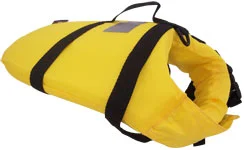Personal Floatation Devices (PFDs)
aka the Life Jacket
A PFD (Personal Floatation Device) is a mandatory requirement when kayaking in most waters around Australia - there are some states where the legislation does not mandate it but we recommend you always paddle wearing a correctly fitted PFD. Studies show that wearing a PFD can increase your chances of survival greatly. The PFD alone is not going to save your life. Let someone know before you head out, a great understanding of weather interpretation, wearing the correct clothing, a good understanding of the basic essential strokes, self and assisted rescues and how to raise the alarm if it all goes to custard is the key to enjoying water sports safely.
Always wear your life jacket
Let someone know before you go
Be aware of your own limitations / capabilities and those of your paddle buddy and the limitations of your kayak. Practise getting back on /in you craft.
Always check the weather forecast (from the BOM) and know how to interpret it for the on-water conditions of the area you are paddling
Carry your phone in a waterproof case (Aquapac)
Undertake training with a qualified instructor
Types of PFD
PFD Type 2 (we use and recommend Type 2 for paddle sports)
PFD Type 1
PFD Inflatable Type 1 (not recommended for paddle sports!)
PFDs for Children (Type 1)
PFD Type 3 (not safety colours!)
Dog PFDs
PFDs we USE and RECOMMEND
PFD Type 2 (Level 50)
This is a buoyancy vest–not a life jacket. It will provide less buoyancy than a PFD type 1 but is sufficient to keep your head above water. Like a PFD type 1 they are manufactured in high visibility colours such as yellow and red.
We use and recommend a PFD Type 2 for adults sea kayaking, recreational kayaking, kayak fishing, white water and surf ski paddling - the best combination of comfort, visibility and buoyancy on the water. They are appropriate for canoeing and kayaking activities and allow you to undertake self or assisted rescues.
Sea Kayaking PFDs ideally have a variety of pockets so you can keep snacks, communications and safety gear close by. Some have hydration pockets on the back for a water bladder The Ultra Trek and Kokotat Outfit Tour are good examples that we use and recommend.
Surf ski paddlers tend to favour shorter, more intense workouts - a more slim-line PFD is preferred, such as the Mocke Racer PFD and Vaikobi V3 Ocean Racer.
For kayak fishing, again you want plenty of pockets - a typical sea kayaking PFD may be fine, although some fishing kayaks have a high backed, comfort seat, so specialty Fishing Kayak PFDs such as the Kokatat Bahia Tour have the buoyancy up high, with just a mesh lower back.
Rescue PFDs for white water and swift water rescues differ from sea kayak PFDs by the addition of a quick-release waist belt and Bungee Tow (Cow’s Tail) - the Kokatat Guide or Ronin Pro, Sea To Summit Leader and NRS Zen Rescue PFDs are good examples of these.
PFD Type 1 (Level 100 or greater)
This is a recognised ‘life jacket’. A PFD type 1 will provide a high level of buoyancy and keeps the wearer in a safe floating position through the use of buoyancy behind the head. They are made in high visibility colours with reflective patches.
PFD Type 1 (Level 100 or greater) are designed for survival situations (and boating!) and can make performing activities such as paddling and self and assisted rescues more difficult.
Inflatable Type 1 PFD (Level 150)
Inflatable Type 1 PFDs are designed to be less bulky and offer no immediate buoyancy until inflated, so people are reluctant to inflate them. Generally when you capsize, buoyancy gives you the opportunity to resolve the immediate problem (keep contact with your kayak and paddle), recover and undertake a self or assisted rescue. We do not recommend these for paddle sports either, due to the annual maintenance requirement and if deployed their bulkiness in the chest region makes self and assisted rescue extremely difficult. If you do utilise this PFD we recommend training in it and understanding its capabilities.
Children's PFDs Type 1 (Level 100)
Children's PFD's are Type 1 (Level 100). They are available sized according to age (years 1-2, 3-4, 4-6, 6-8, 8-10, 12-14) and provide the higher level of floatation in a safe floating position. Smaller sizes for toddlers have an additional strap between the legs to stop smaller children from sliding out.
PFD Type 3 (Level 50S)
This is a buoyancy garment – not a life jacket. They have similar buoyancy to a PFD Type 2 but are manufactured in a wide variety of colours and are shaped or equipped for particular activities, eg. camouflage colours. Their visibility for paddle sports is not always sufficient, hence we prefer Type 2 PFD which are in high visibility colours and have reflective strips.
Dog PFDs
Don't forget about your best friend when you are out on the water! PFDs for dogs (or is that a CFD - Canine Floatation Device) are now available and in a range of sizes to suit your dog. They have a handle on the back so that you can retrieve them when they get overexcited and jump overboard.
We use and Recommend
Kokatat Outfit Tour
Ultra Trek
Ultra Raider Junior
NRS Zen Rescue
Additional safety equipment we recommended to attach to your PFD:
Whistle (Fox 40)
Safety knife
rescueME PLB1
Hydration system (Camelback Antidote 3L) - or secure to floor of the cockpit, keeping the weight low
Silva handheld compass
Aquapac Phone Case to keep your phone safe!
VHF Marine Radio
View our YouTube video for more information on the accessories we attach to our PFD:






